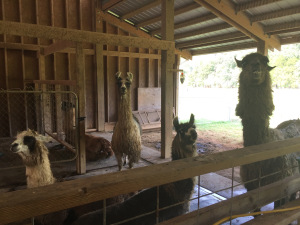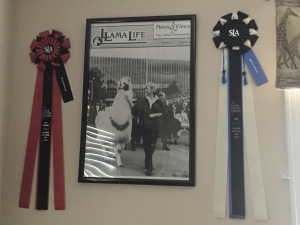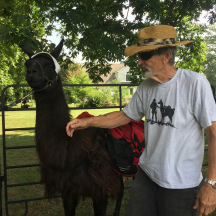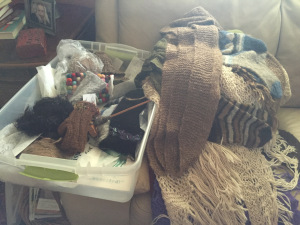Headlines
From Washington to Mississippi, Magnolia Knoll Farm Raises Llamas
Located in New Albany, Mississippi off of Highway 30, lies a dirt road and a white picket fence that leads to a large white house belonging to Nathan and Sandra Shaddinger. Behind their quaint house and gravel driveway lives 10 llamas.
The Shaddingers have been raising llamas since 1990 when they lived in Washington State.
“I spotted a llama on the side of the road, so I made Nathan stop,” said Sandra. “The owners invited us in, we asked some questions and before you knew it, bought 10 acres, built a barn and a fence, and bought two females.”
They showed, bred and packed with their llamas. Now, after living in Mississippi for 10 years, they share their llamas with others for enjoyment and educational purposes.
“We take them to a lot of different things so we can educate people about them,” said Nathan. “In the spring we come to Oxford to the Powerhouse for the Knit Oxford festival.”
Often people don’t know a lot about llamas other than the fact that they spit, but Nathan and Sandra know the ins and outs of their origins, mannerisms and care-taking requirements.
“Llamas come from Peru,” Sandra said. “They’re one of the oldest, domesticated animals. In Peru, there is more Indian art depicting llamas. It’s the second most depicted image behind the sun which is their deity.”
Aside from their Peruvian origins, Sandra explained that llamas are high altitude animals and are good for the wilderness because their two-toed leather pads have a low impact, allowing them to do well in sensitive areas.
Although llamas really do spit, they are gentle animals. “They are very good with people and quiet to have,” Sandra said. “They hum when they aren’t happy. They make an alarm call when they see something strange. It’s a real weird noise, but that’s really all they do.”
Llamas are herd animals that can weigh up to 450 pounds and live to be around 20 to 25 years old. The Shaddingers’ youngest llama is Mississippi Man, a black llama who was born in the state. Their show llama, Critical Mass, is 12 years old.
“He’s our PR (public relations) llama,” said Sandra. “He likes to show off. Josie, our six-year-old neighbor, led Critical Mass at the New Albany Pet Parade this past year.”
Together Nathan and Sandra take care of the llamas by cleaning and feeding them and providing other basic needs.
In the spring they get barrel cuts to take the fiber off the belly area as well as keep them cool in the Mississippi climate and humidity. Their two toes have to be trimmed. They get a vaccination once a year and are dewormed when necessary. They take a mineral vitamin and are given electrolytes to urge them to drink water. The llamas eat carrots, apples, grass and hay. They have no top teeth so they grind their food. They stay in the barn with fans and misters from 11:00 a.m. to 5:00 p.m. daily and have access to 23 acres of land to roam around on.
“The fans and misters are set to automatically start and shut off every day,” Nathan said. “Then around 5:00 p.m. we turn them loose in the field and they all run up on a hill and play king of the mountain.”
With all the upkeep, the Shaddingers do benefit from raising the llamas. They use the elk-like droppings in their garden to grow tomatoes and use the fiber for knitted and felted pieces.
“There’s a lady in West Point, Mississippi who comes and gets all my fiber,” Sandra said. “She always makes me something fun out of it.”
Magnolia Knoll Farm is located in New Albany, Mississippi at 1114 Martintown Road. The Shaddingers can be contacted by email or phone found on their website.
Paige Henderson is enrolled at Meek School of Journalism and New Media. She can be reached at pehender@go.olemiss.edu.
Follow HottyToddy.com on Instagram, Twitter and Snapchat @hottytoddynews. Like its Facebook page: If You Love Oxford and Ole Miss…




































Sandy
July 27, 2016 at 1:13 pm
Love this!!
Fran P Tankersley
August 27, 2016 at 11:33 am
I always enjoy reading about my sister-in-law, brother-in-law and their llamas. My husband and I chose to come to New Albany July 5, 2014 to celebrate our 50th wedding anniversary with family and friends at Sandy and Nat’s lovely estate “Magnolia Knoll”. It was a grand celebration! Sandy, Nat and I did an outstanding job. Nat and Sandy did most of the work as I live in Houston, Tx. We had a 40×60′ tent under the rows of pecan trees in the back of the house. We had old fashion games in the yard for the guest to play. The white tables with white tablecloths were just beautiful after our Master Gardner, Sandy, finished her flower arrangements for each table. The food was catered by a local caterer, who did a wonderful job. All 102 guest gave it rave reviews. We celebrated “An Old South Celebration” with three celebrations in one. We also celebrated our Aunt Mabel Tutor’s 99th birthday and the VA came to honor our Uncle Kiester Tutor’s war injuries at the Battle of the Budge.
The weather in New Albany that day was 85 degrees and no humidity! What a day it was!
People came from TN, IL, TX, AL, Fl and of course MS.
The llamas did what they do best by lining the many fences around Magnolia Knoll for pictures of themselves and their guests.
Thank you, Sandy and Nat for allowing us to make this memory! It is a good day to look back on. Love you guys!